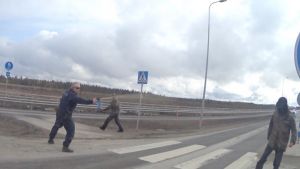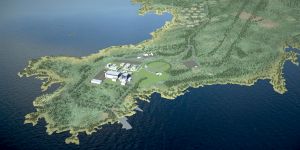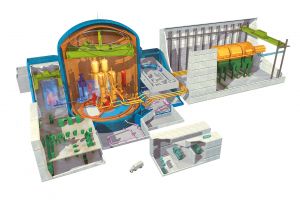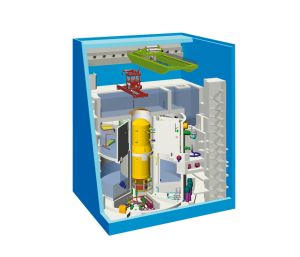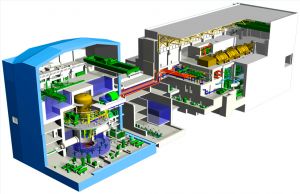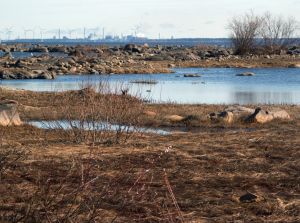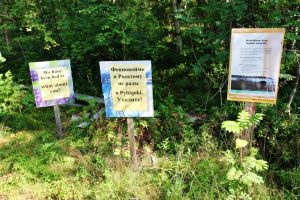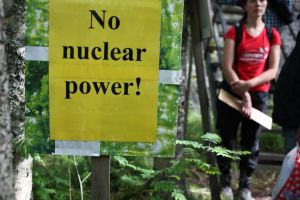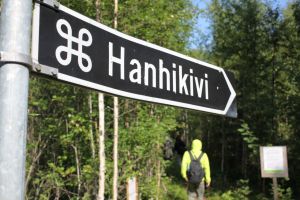Pyhäjoki
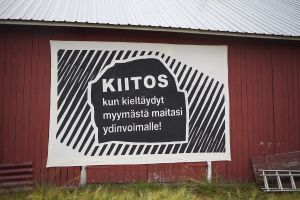 "Thank you to those who do not sell their land to nuclear power" - banner next the road to the proposed Hanhikivi NPP |
The nuclear company Fennovoima (biggest shareholder formerly was the German nuclear company EON; other shareholders e.g. Ruukki (2 %)) wants to build a new nuclear power plant in Finland in Pyhäjoki (formerly they were considering Simo, too). On October 5, 2011 Fennovoima announced their site selection for Pyhäjoki[1][2][3].
Fennovoima about the history of the site selection process:
- "In the beginning of Fennovoima project in summer 2007, the company had almost 40 alternative sites. The number of alternatives was decreased gradually based on assessments and in December 2009 Fennovoima ended up having two alternatives, both located in Northern Finland: Pyhäjoki and Simo municipalities."[2]
Fennovoima about the planned schedule for planning and constructing the NPP at Pyhäjoki:
- "First preparatory works on Hanhikivi will be started in the end of 2012 at earliest. The construction schedule will be elaborated after the plant supplier has been selected. Fennovoima sent bid invitations for Areva and Toshiba in July 2011 and the plant supplier will be chosen in 2012-2013."[2]
Learn more on our website:
- Pyhäjoki: Stop Fennovoima protest camp
- Finland: Entire traffic to Fennovoima-Rosatom's nuke plant construction blocked
- Call for solidarity for hungerstrikers in Pyhäjoki, Finland
- CALLOUT: July approaches, the eviction threat grows - get yourself to Hanhikivi post-haste!
- Dance down Fennovoima! Antinuclear dance event at Hanhikivi 31th of May
- Environmental Impact Assessment on new reactor in Finland
- Pack ice and bad engineering
- Nuclear power is not a good business anymore
- The end of Fennovoima NPP project?
- Shoddy nuclear technology and poor safety culture should not be exported from Russia to Finland
Fennovoimas nuclear power project in Pyhäjoki
In July 2010 the Finnish parliament granted Fennovoima a decision-in-principle for its’ plans to build a new nuclear power plant, but the company has not been able to apply for a construction license from the Finnish government yet. An attempt to construct a new reactor in Pyhäjoki, on Hanhikivi peninsula, a mainly untouched area with many endangered natural habitat types, is one of the most arrogant ones in the whole of Europe. Hanhikivi is an important nesting area for almost twenty endangered bird species, especially significant resting area for migrating arctic birds. If the nuclear power project is realized, the area will dramatically change to an industrial area.
Fennovoima still does not own all the land and water areas they would need for the construction, the land use plans for the nuclear power plant are not legally valid, and the company has not been able to show any solution for the disposal of its’ nuclear waste, which is prerequisite for granting the construction license. At the moment (autumn 2012) the master plan and the more detailed land use plan of the Hanhikivi area are in the Supreme Administrative Court of Finland, because of complaints made by the local NGO Pro Hanhikivi.
During the past few months the company has faced a number of setbacks. Several of the Finnish shareholders have withdrawn from the project, the company has fired the chairman of the board as well as their CEO, and there is a lot of speculation in Finland about the possible collapse of the whole project. The latest turn at the end of October was, that the biggest shareholder in Fennovoima, the German energy giant E.ON announced they will give up on the project and the interest in Fennovoima. (Update: as of February 15, 2013 E.ON handed over their Fennovoima share to Voimaosakeyhtiö, the consortium of Finnish companies now owning 100% of Fennovoima.[4][5]) Still, Fennovoima tries to move ahead with its’ plans at full speed. The company has now started an official process through the Ministry of Employment and the Economy in order to expropriate the land areas they are still lacking. This means that the company is trying to take more than 100 hectares of land by force from private persons in Pyhäjoki.
Pro Hanhikivi association was founded in 2007 in Pyhäjoki, Northern Finland, in order to oppose a new nuclear power plant construction project by Fennovoima. The association is working on local, national and also international levels. During the past five years, Pro Hanhikivi has formulated hundreds of pages of opinions, responses, and complaints on the environmental impact assessment of the project as well as on the decision-in-principle granted to Fennovoima. In addition, Pro Hanhikivi has participated in several levels of land use planning, sent complaints about the project and all its’ official proceedings to all court levels in Finland, and also formulated a petition to the Committee on Petitions of the European Union.
Representatives of the association have visited the Finnish Parliament several times and the European Union (Committee on Petitions) twice, and they have also participated in the Annual General Meeting of E.ON AG in Essen, Germany, in 2009, 2011 and 2012. Pro Hanhikivi now has over 300 members, and the anti-nuclear work against the Fennovoima project continues very intensively.
More information:
- http://www.prohanhikivi.net - NGO Pro Hanhikivi (fin)
- http://www.hanhikivi.net - The Hanhikivi cape (fin, eng, de, sve)
Basic Information
Hanhikivi is a cape which is located in municipality of Pyhäjoki, at North Ostrobothnia, on the coast of Bothnian Bay. Minor piece of the capes end belongs to town of Raahe. The cape is about 5 kilometers long.[6] Hanhikivi means “Goose rock” in English. The name of the area comes from a relic: an erratic block which is located at the capes end.[7]
Hanhikivi area is a significant conservation entity of land uplift coasts. There are none exactly as large unitary forest areas of this kind of coast at North Ostrobothnia. Hanhikivi area includes coast biodiversity, quite representative herb-rich forests of land uplift area, small flood meadows and hardwood-spruce swamps. In addition, the area includes other statutory preserved objects such as sea-shore meadows and gloe lakes. The area of Hanhikivi has been noted in North Ostrobothnia county planning as a nature multipurpose area. There are, also, nationally significant relics and scenically valuable rocky area. Hanhikivi area is partially limited to Parhalahti-Syölätinlahti-Heinikarinlampi-Natura area.[8]
About 63 % of Hanhikivi area has been preserved. About 170 hectares were preserved in Merestä metsäksi project (forest programme) during 2005–2006 by natural values trading, subsidy for preserving ecological values and by buying land to state. There are, also, about 110 hectares preserved in other ways.[8]
Hanhikivi is a very valuable bird migration area. Hietakarinlahti-Takaranta area has been qualified as a nationally important bird area, FINIBA area (Finnish Important Bird Areas). FINIBA areas are remarkable areas for nature conservation. They are nesting and gathering places for threatened species and species for international special responsibility.[9]
Parhalahti-Syölätinlahti and Heinikarinlampi are Natura 2000 area (code FI110420). It is defined as an nationally valuable bird water area. Also, the sea-shore meadows of Maunus are qualified as a regionally valuable traditional landscape and as the last clear-preserved sea-shore meadows. The surface area is about 275 hectares.[9]
Hanhikivi is also the name of a fixed relic, the delimeter from historical age. It has been qualified as a nationally valuable object and protected by the Antiquities Act (295/63). The Treaty of Nöteborg (Pähkinäsaaren rauha), also known as Treaty of Oreshek, is the peace treaty that set the first east border concerning Finland. The treaty was the first settlement between Sweden and Novgorod Republik regulating their border. The border began at Rajajoki, went to northwest across the Karelian Isthmus and ended to coast of Bothnian Bay. Hanhikivi is found as the delimiter of the Treaty of Nöteborg.[10]
Pyhäjoki
source: lecture of Jyri Laakso, Pyhäjoki municipality representative[11]
History of Pyhäjoki:
- A governing county founded in 1573 by Johan III, the king of Sweden
- As a municipality, Pyhäjoki started its operations in 1865
- The current borders were set in 1895 when Merijärvi congregation became independent from Pyhäjoki
Basic Facts about Pyhäjoki:
- about 3,400 residents
- located in North Ostrobothnia
- active villages Parhalahti, Yppäri, Pirttikoski, and Liminkakylä
- part of Raahe region with approximately 35,000 residents
- total area: 549 km²
- land 542 km² and water 7 km²
- 88 km of coastline on the Bothnian Bay
- around 150 companies and 130 farms
Hanhikivi 1 Nuclear Power Project from the Standpoint of the Municipality:
- The plant site is located in Hanhikivenniemi (Hanhikivi Peninsula) about seven kilometers north from the center of Pyhäjoki
- Summer 2007: the nuclear power company Fennovoima had almost 40 alternative site options
- 2008: On EIA (Environmental Impact Assessment) Municipal Council of Pyhäjoki voted 15-6 for the process
- December 2009 two alternatives left for plant site Pyhäjoki and Simo
- 2010 new regional land use plan for nuclear power was ratified by the Ministry of the Environment
- 2010 Municipal council of Pyhäjoki voted 15-6 for the detailed and partial master land use plans
- 2010 On A-Decision-in-Principle of Parliament of Finland Municipal council of Pyhäjoki voted 16-5 for the principle
- October 2011 Pyhäjoki was chosen to be the plant site
- June 2013 Appeals against the new master and detailed land use plans in Pyhäjoki were rejected by the Supreme Administrative Court
Why Pyhäjoki instead of Simo: According to Fennovoima, "Several technical features in Pyhäjoki were more favorable. Due to technical benefits it is more feasible to construct a nuclear power plant to Pyhäjoki. Assessments show that the bedrock in Pyhäjoki is more solid. This means that operations like excavation works are easier to carry out. In Pyhäjoki, seismic design values are lower than in Simo. This has an impact on the design of the structures, systems and equipment of the plant. The length needed for cooling water tunnels is about one kilometer shorter in Pyhäjoki. In addition to these technical features, Pyhäjoki's benefit is that there are very few permanent residents and summer houses near the power plant site, which means that the construction will cause less disturbance for the neighborhood" (Fennovoima press release, 2011).
Hanhikivi 1 project: some impacts on Pyhäjoki:
- At its peak, 3,000-4,000 people participate in the construction process
- Provides about 25,000 man-years of work during the construction process
- about 450 man-years of work per year during the usage time
- Property taxes over the 60-year-lifecycle approximately €140-200 million and municipal taxes €160-200 million
- The value of the land sale will be €2.76 million when it is realized
- Strengthens permanent population in the area approximately with 1,000 people and helps providing jobs for the educated young adults and returnees
Hanhikivi 1 project: preparation:
- Land use process follows "Growing Power 2025" plan > new land use plans and land acquisition
- Several regional co-operation bodies
- Projects:
- Ollinmäki Industrial Area Project > almost finished
- Hanhikivi Multisectoral Coordination and Interconnection project > Liaison Secretary Helena Sydänmetsä
- Development project > Jyri Laakso
Links
- Voimaosakeyhtiö SF - shareholder group of Fennovoima
- Fennovoima - supposed owner and operator of Hanhikivi NPP
- http://uraanivoima.com/?p=pyhajoki Finnish
- Pro Hanhikivi homepages: http://www.hanhikivi.net/en/en_hanhikivi.php
- Pro Hanhikivi blog: http://prohkivi.vuodatus.net/ Finnish
- Pack ice and bad engineering
Further information resources
- Nuclear Site Fennovoima in flexRISK
- Status of proposed nuclear plants in the Baltic Sea region as of August 29, 2012[12]:
- Hanhikivi NPP:
- proposed construction start: n/a
- proposed operation begin: 2020
- Hanhikivi NPP:
- Rosatom has expressed preliminary interest in supplying a AES-2006 reactor for Fennovoima as well as buying a stake in the company already in February 2013.[13]
- Fennovoima press release as of July 3rd, 2013: Fennovoima continues with Rosatom
- World Nuclear News (nuclear lobby service) as of July 3rd, 2013: Fennovoima focuses on Rosatom
- Rosatom offered the reactor design AES-2006 to Fennovoima to be built in Pyhäjoki.[14]
- art project against Fennovoima NPP in Pyhäjoki
- media releases: Case Pyhäjoki gathers international artists to Pyhäjoki, Case Pyhäjoki kokoaa taiteilijoita Pyhäjoelle, Case Pyhäjoki julkaisi ohjelmansa, Case Pyhäjoki – Artist reflections on nuclear influence
- presentations provided with Case Pyhäjoki:
- performances:
- FENNOVOIMA’s Image Washing, Manipulating Public Opinion & Normalizing Their Presence
- Ollinmäki: Smooth Roads are Waiting
- Opening and closing doors
- Lampinsaari mine on the edge of natures
- Karaoke, Social Media and Nuclear Song Stand-ups
- Experience of Case Pyhäjoki
- As of spring 2013, the boss of the Finnish nuclear safety authority, Jukka Laaksonen, switched to Rosatom - a couple of months later it was announced that Rosatom would possibly take over the Pyhäjoki NPP project.[17]
- Signs of the times - short article giving an impression of an excursion to the proposed NPP site
- FENNOVOIMA’s Image Washing, Manipulating Public Opinion & Normalizing Their Presence
- With joy and love - a kind of evaluation of the project
- As of September 3, 2013, Fennovoima publicly announced to buy a Russian VVER-1200 (AES-2006) reactor from Rosatom and to transfer 34 % of Fennovoima's ownership to the Russian state company[18]
- press release: People in Pyhäjoki have been disregarded because of the Fennovoima nuclear plans as of March 26, 2015
- ↑ http://www.yle.fi/uutiset/news/2011/10/new_nuclear_reactor_to_be_built_at_pyhajoki_2925634.html as at October 5, 2011
- ↑ 2.0 2.1 2.2 http://www.fennovoima.com/en/press-releases/press-releases/fennovoima-nuclear-power-plant-to-be-constructed-in-pyhajoki as at October 6, 2011
- ↑ http://www.wirtschaftsblatt.at/home/schwerpunkt/greeneconomy/eon-konsortium-baut-noerdlichstes-akw-der-eu-in-finnland--491109/index.do?_vl_pos=r.3.NT as at October 7, 2011
- ↑ http://www.handelsblatt.com/unternehmen/industrie/beteiligung-eon-zieht-sich-aus-letztem-akw-projekt-zurueck/7790040.html as at August 9, 2013
- ↑ http://www.voimaosakeyhtio.fi/en/tiedotteet.php as at August 9, 2013
- ↑ map link
- ↑ http://www.hanhikivi.net/en/hanhikivi.php as at May 9, 2010
- ↑ 8.0 8.1 http://www.hanhikivi.net/en/hanhikivi.php?sivu=preservingofhanhikivi as at May 9, 2010
- ↑ 9.0 9.1 http://www.hanhikivi.net/en/hanhikivi.php?sivu=birdarea as at May 9, 2010
- ↑ http://www.hanhikivi.net/en/hanhikivi.php?sivu=hanhikivirelic as at May 9, 2010
- ↑ http://www.nuclear-heritage.net/images/0/00/Case_Pyhajoki_presentation_introduction_municipality.pdf as at August 7, 2013
- ↑ composition by Bernd Ebeling, http://contratom.de as at August 29, 2012
source: World Nuclear Industrial Status Report 2012, Schneider, M. et al.; Nuclear Power Reactors in the World, IAEA, Vienna, 2008 - ↑ Reuters 23.2.2013: Russia's Rosatom says in talks with Finnish firm on nuclear reactor, http://uk.reuters.com/article/2013/02/23/business-us-fennovoima-rosatom-idUKBRE91M08I20130223 in: Greenpeace briefing: "Rosatom nuclear new build plans outside Russia", 2013-07-22
- ↑ source: Greenpeace briefing: "Rosatom nuclear new build plans outside Russia", 2013-07-22
- ↑ https://www.dropbox.com/s/wvmtapav36aajyp/Jyri-Laakso_Introduction_Case-Pyh%C3%A4joki_010813.pdf as at August 7, 2013
- ↑ https://www.dropbox.com/s/oiu3ztcypxtk7la/Tapio-Litmanen_Finnish-Exceptionalism_Case-Pyhajoki_010813.pdf as at August 8, 2013
- ↑ http://www.hs.fi/english/article/Retired+Finnish+nuclear+safety+boss+hired+by+Russian+nuclear+energy+company/1135270343566 as at July 30, 2013
- ↑ http://www.nuclear-heritage.net/index.php?title=PR:Shoddy_nuclear_technology_and_poor_safety_culture_should_not_be_exported_from_Russia_to_Finland&oldid=71980 as at November 29, 2013
Photos
The images give an impression about the area affected by these nuclear developments.
- Additional Pyhäjoki photos
...additionally the long-term radioactive waste would have to be stored somewhere safely (and that's not possible).
Ice floes stacked up by the elements
Pyhäjoki on the Nuclear Baltic Map: nr. 34
